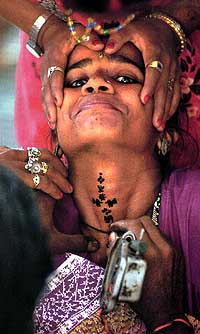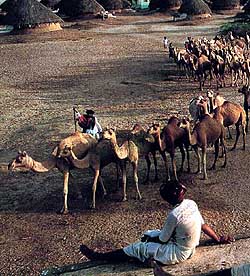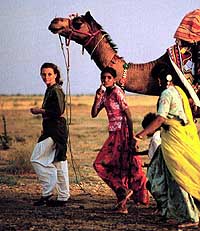by Chalerm Raksanti
The Rabari are one of perhaps a dozen or so castes of
livestock-breeding, semi-nomadic peoples of northwest India. Their origins
are unknown, and old census reports dismiss them as camel rustlers, cactus
eaters, and stealers of wheat. They have also acted as messengers to great
armies during regional warfare.
 Rabari
bride being tattooed before her wedding.
Rabari
bride being tattooed before her wedding.
According to one tradition, all the Rabari once lived
in Jaisalmer, in the state of Rajasthan, in the Great Indian Desert. Over
the centuries they spread into many other states, integrating themselves
into Hindu culture as they went, splintering into countless sub-castes,
but always retaining their unique ways and differences.
Today, it is clear that in modern India their way of
life is in trouble. The Rabari population is estimated to be about
270,000. They now often keep only a few camels for transport. Many earn a
living by selling sheep and goats for meat, dung for fertilizer, and wool.
With open land filling up through development, and conflicts with settled
people increasing, more and more the Rabari are forced to give up their
herds and look for other work.
 Herdsman
assists a kid to suckle.
Herdsman
assists a kid to suckle.
An early October morning in Gujarat finds the Rabari
camped in tarpaulin shelters, preparing for their annual migration they
call the “dang”. This is when groups of from five to fifteen families
set out with their livestock in search of green pasture. They wander from
autumn through the following spring, during the dry months between the
southwest monsoons. There is an urgency to get all the work done in
preparation to decamp. Women run barefoot over stones and thorns, chasing
lambs. The shepherds pound the ground with their staffs and curse the
sheep as they corral them into makeshift pens. Each shepherd has a
slightly different call, whistle or shriek to call his flock and the noise
is deafening. Then one watches the gentle firmness with which a herdsman
will get a reluctant goat to suckle a kid and realizes how precious these
animals are to the Rabari.
 Rabari
camel train departs for greener pastures.
Rabari
camel train departs for greener pastures.
By day the Rabari men guard their animals from wolves
and jackals. The forests are also crawling with bandits. At night he herds
them together with other men’s livestock for protection against thieves.
A pistol or a rifle is essential for protection, but most Rabari have only
their staffs and sling shots. Besides stealing animals, the bandits often
kidnap women for random. Village police provide no justice since the
system is rife with corruption.
 Fine
hand crafted jewelry adorns this woman’s hands during festive occasions
Fine
hand crafted jewelry adorns this woman’s hands during festive occasions
Throughout India grazing land is rapidly shrinking.
Previously, farmers and nomads enjoyed a symbiotic relationship. Pastoral
nomads provided farmers with dung in exchange for grazing privileges.
There was enough room for everyone. The farmers tilled the arable land and
the grazers fed their herds in land unfit for farming. Unfortunately,
times have changed and although the farmers still want the dung, they do
not want the nomad’s herds eating the cash crop standing between them
and financial ruin.
 Young
Rabari women on the trek across the Great Indian Desert.
Young
Rabari women on the trek across the Great Indian Desert.
Still one can still see a timeless train of camels
leaving the villages and setting off for the Rabari’s annual migration.
They migrate south in a rough loop, through a labyrinth of sea and desert,
into the fertile farmlands of the neighboring Surashtra region, then back
again before the advent of the pounding monsoon rains.

 Rabari
bride being tattooed before her wedding.
Rabari
bride being tattooed before her wedding. Herdsman
assists a kid to suckle.
Herdsman
assists a kid to suckle. Rabari
camel train departs for greener pastures.
Rabari
camel train departs for greener pastures. Fine
hand crafted jewelry adorns this woman’s hands during festive occasions
Fine
hand crafted jewelry adorns this woman’s hands during festive occasions Young
Rabari women on the trek across the Great Indian Desert.
Young
Rabari women on the trek across the Great Indian Desert.

